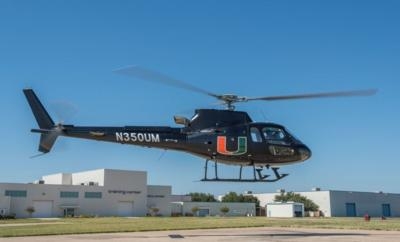One-Of-A-Kind Flying Laboratory Supports Critical Climate And Human Health Research
The University of Miami (UM) Rosenstiel School of Marine and Atmospheric Science unveiled today its one-of-a-kind flying scientific laboratory. The Helicopter Observation Platform (HOP) allows scientists to obtain vital information about our climate and human health.

The commercial Airbus Helicopters H125 aircraft (formerly AS350 B3e) is equipped with state-of-the-art technology to support the research missions of the Rosenstiel School scientists and research institutions around the world by improving our understanding of Earth’s environmental processes. The aircraft is capable of collecting critical scientific information at the Earth’s surface, whether marine or continental, and the thin atmospheric boundary layer above it, where much of the action for the climate system is taking place.
Fully fueled and with both pilot and co-pilot on board, the HOP can carry a scientific payload of up to 1,000 lbs internally (about 3,000 lbs externally) and fly for nearly four hours without refueling at an airspeed of 65 knots, which is ideal for in-situ observations. Its fast cruising speed is 140 knots and its range, at that speed, is 350 nautical miles.
HOP will facilitate in scientific studies of seasonal events, such as Saharan dust storms, which have an impact on marine ecosystems, global climate, air quality and hurricane formation. The aircraft can also aid in identification and rapid assessment of human hazards, such as “red tide” events, sinkholes, and post-disaster measurements. The helicopter’s ability to access remote areas makes it ideal for remote environmental exploration and wildlife studies.
With HOP’s advanced technology for studying key physical, chemical and biological processes near the Earth’s surface, it fills an important research gap in airborne sea-surface observations. Its hovering capability is also ideal for conducting various types of remote-sensing observations. It provides a unique and essential component of airborne measurement whose purpose, among others, is to quantify the exchanges of gases and energy at the Earth surface, as well as aerosol properties that affect the environment, the climate system, and human health.
The new aircraft complements an array of cutting-edge research resources at UM, including the R/V F.G. Walton Smith, an advanced research catamaran designed for tropical oceanography; the Center for Southeastern Tropical Advanced Remote Sensing (CSTARS) a real-time, high-resolution satellite imagery facility; and the new one-of-kind SUSTAIN (SUrge STructure Atmosphere INteraction) research facility, the only laboratory in the world with a wind-wave-storm surge simulator capable of generating Category 5 hurricane-force winds in a 3-D test environment.
The Airbus Helicopter was funded by generous donations from the Batchelor Foundation, which provided nearly half of its acquisition cost through a challenge grant, the G. Unger Vetlessen Foundation and an anonymous donor contributed a significant portion of the matching funds.
(Image provided by the University of Miami)
 Airborne 06.30.25: US v ADS-B Misuse, Natl STOL Fire, Volocopter Resumes
Airborne 06.30.25: US v ADS-B Misuse, Natl STOL Fire, Volocopter Resumes NTSB Prelim: Piper PA-23
NTSB Prelim: Piper PA-23 ANN FAQ: Submit a News Story!
ANN FAQ: Submit a News Story! Classic Aero-TV: One Mans Vietnam
Classic Aero-TV: One Mans Vietnam Klyde Morris (06.30.25)
Klyde Morris (06.30.25)



